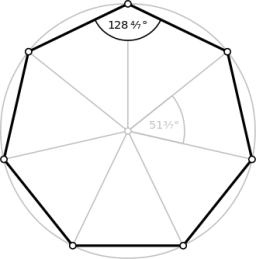Probability 81637
We randomly select three different points from the vertices of a regular heptagon and connect them with line segments. The probability that the resulting triangle will be isosceles is equal to:
(A) 1/3
(B) 2/5
(C) 3/5
(D) 4/7
(A) 1/3
(B) 2/5
(C) 3/5
(D) 4/7
Final Answer:

Tips for related online calculators
Need help calculating sum, simplifying, or multiplying fractions? Try our fraction calculator.
Calculation of an isosceles triangle.
See also our trigonometric triangle calculator.
Would you like to compute the count of combinations?
Calculation of an isosceles triangle.
See also our trigonometric triangle calculator.
Would you like to compute the count of combinations?
You need to know the following knowledge to solve this word math problem:
combinatoricsplanimetricsbasic operations and conceptsnumbersGrade of the word problem
We encourage you to watch this tutorial video on this math problem: video1
Related math problems and questions:
- Draw a triangle
 We have line segments with lengths of 3cm, 5cm, 6cm, 7cm, and 9cm. What is the probability in % that if I randomly select three of them, I will be able to draw a triangle?
We have line segments with lengths of 3cm, 5cm, 6cm, 7cm, and 9cm. What is the probability in % that if I randomly select three of them, I will be able to draw a triangle? - Probability - triangles
 We have five lines with lengths of 3cm, 5cm, 7cm, 9cm, and 11cm. What is the probability that we will be able to construct a triangle with randomly selected three?
We have five lines with lengths of 3cm, 5cm, 7cm, 9cm, and 11cm. What is the probability that we will be able to construct a triangle with randomly selected three? - Drawing from a hat
 When drawing numbers from a hat from 1 to 35, we select randomly given numbers. What is the probability that the drawn numbers will be divisible by 8 and 2?
When drawing numbers from a hat from 1 to 35, we select randomly given numbers. What is the probability that the drawn numbers will be divisible by 8 and 2? - One green
 There are 45 white and 15 green balls in the container. We randomly select five balls. What is the probability that there will be one green ball maximally?
There are 45 white and 15 green balls in the container. We randomly select five balls. What is the probability that there will be one green ball maximally? - Intersection 3383
 A regular 15-angle is given. A triangle is formed if we connect points 3 and 7, 13 and 10. The vertices are 3 and 13, and the lines' intersections are 3.7 and 13.10. We are to determine the angle size formed by sides 3.7 and 13.10. These numbers indicate
A regular 15-angle is given. A triangle is formed if we connect points 3 and 7, 13 and 10. The vertices are 3 and 13, and the lines' intersections are 3.7 and 13.10. We are to determine the angle size formed by sides 3.7 and 13.10. These numbers indicate - In class 24
 There are a total of 16 students in the class, a quarter of whom are girls. We randomly select a team of five. Determine the probability that the team will have: a) at least 4 girls. b) at most 1 girl. c) no girls.
There are a total of 16 students in the class, a quarter of whom are girls. We randomly select a team of five. Determine the probability that the team will have: a) at least 4 girls. b) at most 1 girl. c) no girls. - Probability 31101
 There are 16 balls in the box, of which seven are white, and nine are blue. We randomly select two balls. What probability will there be exactly two white balls among the selected ones?
There are 16 balls in the box, of which seven are white, and nine are blue. We randomly select two balls. What probability will there be exactly two white balls among the selected ones?
